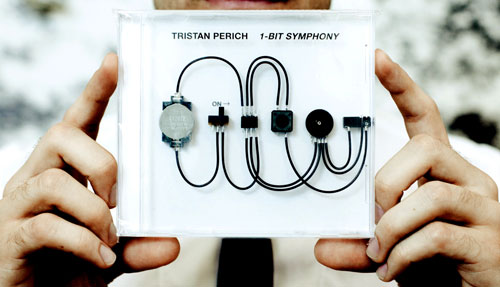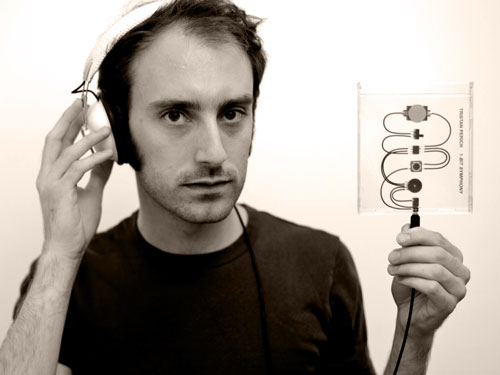MyMac interview with innovative composer and artist TRISTAN PERICH. His “1-Bit Symphony” will soon be available for affordable purchase and listening. This symphony is percussive, techno, polyphonic, rhythmic, melodic, and portable.
MYMAC: What are the inherent musical attributes and limitations of the microchip for a composition, Tristan?
TRISTAN: Since high school, when I first learned about the foundations of mathematics and logic, I have been attracted to simple models that directly embody certain abstract systems. The hardware I use, simple microprocessors that run around 8mhz and carry about 8kb of data, embody these systems more transparently than a laptop, for instance. Their outputs are inherently 1-bit, generally to communicate with other chips or hardware via binary information. By connecting these 1-bit outputs to an audio jack, I have very direct control in code over the audio waveform. Musically, the 1-bit waves I use are all simple oscillations at set pitches. I explore the expressive complexity of 1-bit audio more in my noise trio, the Loud Objects, but in my own formal work I prefer to use sounds that are simpler to express in code, such as square waves.
MYMAC: Why didn’t you use any artwork on your jewel case, especially since you are a talented visual artist?
TRISTAN: I try not to mix my works that don’t explicitly belong together. While the concepts I work with generally relate to information and simple computational processes, I find each work is ultimately about that relationship expressed in a single medium. Sometimes, when a work relates different media I’ll combine then, like using my 1-bit video televisions as architectural building blocks along with 1-bit music in my dance work, Impulse Manifold, or when I perform in front of my machine drawings for visual synergy. Creating a complex cover for 1-Bit Symphony would muddle what I’m trying to convey by introducing unrelated elements. There is a method in linear algebra called finding the basis for a set of vectors, which involves shedding any extra dimensions in their expression. It’s a little like that.
MYMAC: Is each performance of your 1-BIT SYMPHONY exactly identical, or will there be variations?
TRISTAN: Closed computational systems (those that don’t explicitly take input from the natural world) will run their software the same every time. Because of this, in order to incorporate randomness into software, the computer must be seeded with some true randomness from the real world. I find this to be a fascinating quality of machines, and have focused on simple processes to accentuate it. In contrast, my Machine Drawings employ randomness and order to call attention to the machine’s limitations in each. The execution of my music is identical from copy to copy of 1-Bit Symphony. However, the microchips different slightly in how their internal clocks respond to input power. Some will playback slightly faster (and higher pitched) and others slower.
MYMAC: Why not include a second battery, just in case?
TRISTAN: The included battery should last twenty or so hours, maybe more, of continuous playback. They’re inexpensively available from any Radio Shack or pharmacy, so I didn’t feel the need to include a second. I’d be really flattered if so many people listened long enough to warrant including an extra. Probably by that point the flimsy CD case would be shattered beyond anything.
MYMAC: Is there a way to pause/play within one movement?
TRISTAN: To keep the hardware to a minimum, I opted to only include a fast forward/skip button. I find that user interfaces with any degree of ambiguity prove frustrating, and having a second “button,” without much utility, wouldn’t be that interesting. I’m not trying to create a replacement for the iPod, and I didn’t feel that pausing was all that important to the listening experience.
MYMAC: What is your physical setup when you are programming, and when loading your music onto a chip? Do you have a photo you can provide?
TRISTAN: I’ve written the software and music in Assembly, a fascinating language where each line of code becomes a single instruction for the processor. This ultimately turns into a single machine-readable file that gets transferred to the chip via a simple programming interface, with one end that plugs into the chip and the other into my laptop. The code can then be transmitted in a few seconds to the chip, which is then self-contained and runs its software as soon as it is connected to power.
MYMAC: Your audio track is loud through standard headphones. Why not warn listeners to turn the volume all the way down at first, for safety?
TRISTAN: Sorry! I tried to mix the video to be similar to other content on the web but perhaps the silence at the beginning is a bit misleading. Of course, the device itself comes with a volume knob that is preset to a natural level. That said, the tones are harsh (one reason I love them) and people should understand how loud volume can damage their hearing.
MYMAC: Is it technically necessary to have your music perform in units of four or eight beats, or is it possible to have it in 3/4 or odd time signatures?
TRISTAN: While the sample from the video is in a 4-beat time signature, most of the album is not. One of the aspects of the composition I specifically tried to pull out was an ambiguity in meter, where sections or lines of music locally sound in 3 or 4, without a long form that fits that meter, or other voices in the same section might move at a different rate. In other parts I tried to use chord changes to make the music feel metered while actually being erratic. At the end, meter dissolves entirely.
MYMAC: Who are your musical godfathers? What listening can our MyMac readers and listeners do to learn more about the evolution of serious polyphonic electronic compositions?
TRISTAN: My sense of simple melodic and rhythmic processes came from listening to early Philip Glass as a child. My parents played it for me since birth and I can’t count how many of his concerts I fell asleep during as a kid. Later, Steve Reich and Terry Riley joined the mix. All these composers integrate electronics both as instruments but also as a conceptual mode of thinking about composition. Less well known are composers like Marianne Amacher, John McGuire, Michael Gordon, or Phill Niblock.
MYMAC: It has a good beat, but can we dance to it? Are you part of the electronic club scene, albeit from a digital, electronic point of origin?
TRISTAN: I think I used to be more a part of the electronic music world. The first album came out of a New York scene revolving around the FischerSpooner salon, a weekly art happening with free beer, art and great music. That and the chiptunes scene, which I used to perform with more regularly. Now that my music has become more formalized, I don’t fit into those worlds as well anymore. But I believe strongly that rhythm is important, and I play with it on the album, moving from more accessible parts to sections that I hope are more challenging to listen to.
Learn more about Tristan and his “1-Bit Symphony” here and here.
Photo credits: Donna Yee (edited for MyMac by John Nemo)


